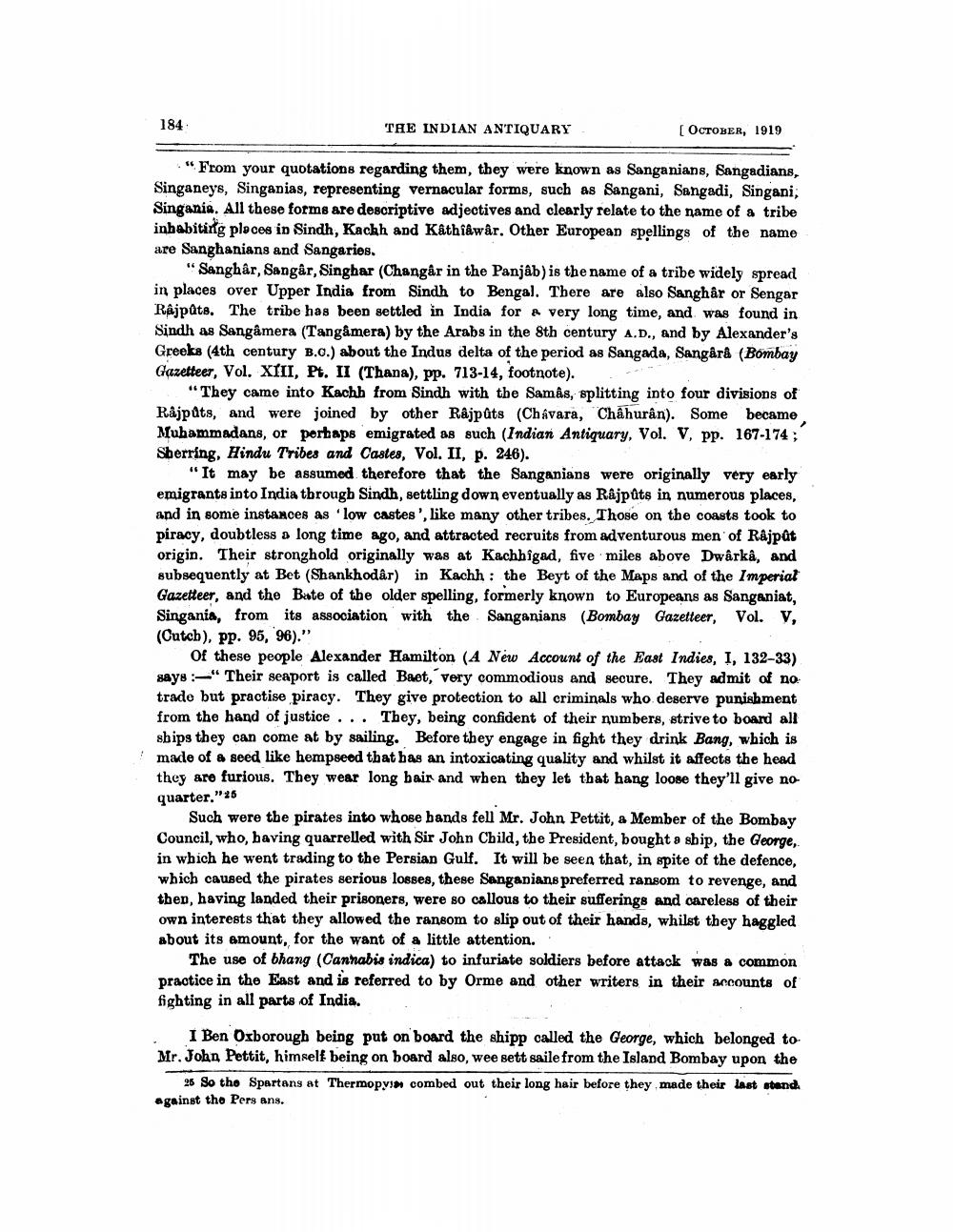________________
184
TAE INDIAN ANTIQUARY
[OCTOBER, 1919
"From your quotations regarding them, they were known as Sanganians, Sangadians, Singaneys, Singanias, representing vernacular forms, such as Sangani, Sangadi, Singani, Singanis. All these forms are descriptive adjectives and clearly relate to the name of a tribe inhabiting places in Sindh, Kachh and Kathf&wâr. Other European spellings of the name are Sanghanians and Sangaries.
"Sanghår, Sangår, Singhar (Changår in the Panjâb) is the name of a tribe widely spread in places over Upper India from Sindh to Bengal. There are also Sanghår or Sengar Rajpate. The tribe has been settled in India for a very long time, and was found in Sindh as Sangâmera (Tangåmera) by the Arabs in the 8th century A.D., and by Alexander's Greeks (4th century B.c.) about the Indus delta of the period as Sangada, Sangårå (Bombay Gazetteer, Vol. XIII, Pt. II (Thana), pp. 713-14, footnote).
"They came into Kachh from Sindh with the Samas, splitting into four divisions of Rajpats, and were joined by other Rajputs (Ch Avara, Châhurân). Some became Muhammadans, or perhaps emigrated as such (Indian Antiquary, Vol. V, pp. 167-174 ; Sberring, Hindu Tribes and Castes, Vol. II, p. 246).
"It may be assumed therefore that the Sanganians were originally very early emigrants into India tbrougb Sindh, settling down eventually as Rajputs in numerous places, and in some instances as 'low castes ', like many other tribes. Those on the coasts took to piracy, doubtless a long time ago, and attracted recruits from adventurous men of Rajpat origin. Their stronghold originally was at Kachhigad, five miles above Dwarka, and subsequently at Bet (Shankhodår) in Kachh : the Beyt of the Maps and of the Imperial Gazetteer, and the Bate of the older spelling, formerly known to Europeans as Sanganiat, Singania, from its association with the Sanganians (Bombay Gazetteer, Vol. V, (Cutch), pp. 95, 96)."
Of these people Alexander Hamilton (A New Account of the East Indies, I, 132-33) way! -" Their seaport is called Baet, very commodious and secure. They admit of no trade but practise piracy. They give protection to all criminals who deserve punishment from the hand of justice ... They, being confident of their numbers, strive to board all ships they can come at by sailing. Before they engage in fight they drink Bang, which is made of a seed like hempseed that has an intoxicating quality and whilst it affects the head they are furious. They wear long hair and when they let that hang loose they'll give no quarter."26
Such were the pirates into whose bands fell Mr. John Pettit, a Member of the Bombay Council, who, having quarrelled with Sir John Child, the President, bought a ship, the George, in which he went trading to the Persian Gulf. It will be seen that, in spite of the defence, which caused the pirates serious losses, these Sangapians preferred ransom to revenge, and then, having landed their prisoners, were so callous to their sufferings and careless of their own interests that they allowed the ransom to slip out of their hands, whilst they haggled about its amount, for the want of a little attention.
The use of bhang (Cannabis indica) to infuriate soldiers before attack was a common practice in the East and is referred to by Orme and other writers in their accounts of fighting in all parts of India.
I Ben Oxborough being put on board the shipp called the George, which belonged to Mr. John Pettit, himself being on board also, wee sett saile from the Island Bombay upon the
26 So tho Spartans at Thermopyin combed out their long hair before they made their last stand, against the Pers ans.




